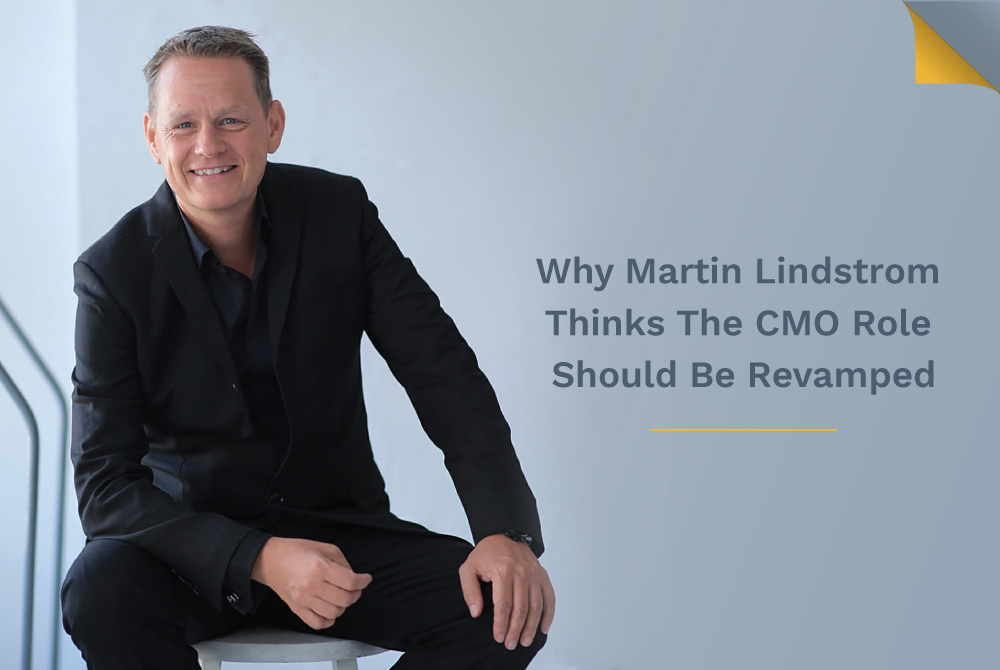Martin Lindstrom thinks the role of the CMO needs a transformation.
The marketer, author, and founder of the culture-and-transformation consultancy Lindstrom Company says the reason the typical CMO tenure is as short as 18 months is because the organizations they work for tend to be siloed. As a result, the CMO’s remit is only a fraction of what it should be.
“The current format is broken, simply because you can’t isolate divisions into silos anymore,” Lindstrom said during a recent Brand Innovators Livecast keynote talk. “Consumers assume everything is seamless, but behind the scenes at the company, it’s not. You have all these silos working separately, not talking to each other. This is where the CMO enters the picture, trying — usually with less than perfect success — to orchestrate it all together. Someone needs to be on top of the brand. In my opinion, that should be the CMO.”
This issue isn’t necessarily the CMO’s fault. Some of it is inertia, as well as the historical default perception of what a CMO should be. However, the market has been changing for years, propelled by technology and new competition, and the CMO role hasn’t kept up. Lindstrom has a unique viewpoint into this: his company has worked with countless brands on business and culture transformation, helping those organizations become more efficient and aligned on overall goals.
Lindstrom thinks that an organization’s culture plays a critical role in both the success of the company and the external perception of the brand, and he believes the CMO should have a say in the development of the culture. Now is the perfect time to take ownership and improve the company’s culture, said Lindstrom. “Here’s the fact: Today no one owns the company culture. HR is busy acting as an extended legal function, Operation is busy making the wheels in the wheelhouse spin, Comms is busy pleasing the Street. So where does culture live? In my opinion, the CMO should run with it.”
Below are five key takeaways from Lindstrom’s Brand Innovators fireside chat, which focused on life post-COVID-19, how to improve company culture, and how to redefine the CMO role. To see the talk in its entirety, go here and register to view.
We need to innovate new ways to create tactile experiences remotely, to fulfill our human need for touch.
“Touch is one of the most important factors for us to stay alive and thrive,” Lindstrom said, citing the current quarantine’s lack of tactile experiences as a critical obstacle for creating lasting memories and brand experiences.
“I think there are many things we can do as marketers to substitute for touch. Many years ago, I introduced a term — ‘clicks and mortar’ — the idea of carefully balancing offline and online according to the strength of each channel. Over the past years, we’ve worked hard to re-introduce physical interactions through products and services; science indicates a near triple memory encoding if you appeal to three senses, rather than just one or two. In partnership with a large food distribution company, we combined virtual broadcast shows with a physical ‘advent calendar’ that is displayed in the rear of each store. The calendar offers 30 small doors, each displaying a real physical product for the local grocery store owners to touch, smell, and taste. Every day, the retailers watch a live streaming show and then are given a ‘key’ to open the physical room in the advent calendar. The impact of us tapping into the five senses has been remarkable, especially during these COVID-19 days, in which our sense of touch is under-stimulated.”
Now is the time to perfect your brand’s company culture.
One of Lindstrom Company’s key clients is Maersk, the largest shipping company in the world. With 88,000 employees, Maersk controls 21 per cent of all global trade. Lindstrom got a front-row seat to how overly technology-dependent the company had become, when he visited their offices in the midst of a cyber-attack in 2017. The management team, overseeing such an enormous volume of shipping activity, had been locked to their computer screens. Suddenly their computers froze, and they had to interact face-to-face with their colleagues.
“One-fifth of all the world’s shipping disappeared over night. As we were there standing in the offices, we realized we had to interact with the world in a different way. The cyber-attack prevented the management team from communicating via email, so they had no other option than to walk the offices daily. For the first time, they were highly visible in front of the thousands of staff worldwide.
“Recently, a senior executive at Maersk told me: ‘Hey, the fact that we went through the cyber-attack actually meant we were better prepared for COVID-19. As far as I know, Maersk is the only company with experience operating under an unannounced force majeure, an extreme situation where you really cannot promise delivery on a certain time. We’ve completely steered around the current COVID-19 crisis.’ Managers can’t walk the offices, but they decided to create virtual lunches every day with head of sales, head of marketing, and on down through the whole organization across time zones. People started to connect on an emotional scale, and despite having 88,000 staff, the company still feels entrepreneurial. They’re maintaining that human dimension through the crisis.
“Remember, the best time to build a brand is when customers are in need. Well, that’s now. If you are able to truly motivate your staff, empower them, and lift their spirits through the culture, then the customers will feel it, too. Remember: This is just another form of branding.”
CMOs should see themselves at the center of everything in the company.
Lindstrom said that CMOs should start envisioning expanded roles for themselves, outside of what they may think the default for the role is.
“The most important thing a CMO can do today,” said Lindstrom, “is to avoid locking yourself into the role of brand person only. Instead, see yourself as the person at the center of it all.” That means CMOs should go beyond viewing their remit as control of ads and marketing; instead, they should oversee every single touchpoint of the company. “What I’ve realized is that organizations are driven by individuals,” said Lindstrom, “and these individuals are the face to the outside world. This includes the folks in the call center, reception, the front desk, the help desk, the delivery guy…. If these people do not convey the message of the brand to the outside world — or even worse, if their actions are in conflict with what the ads or commercials are saying — then the brand collapses. I know it sounds super simple, but the reality is that 9 out of 10 companies completely fail this simple golden rule.”
CMOs should expand their roles to include company culture.
Ultimately, company culture is a huge factor into a brand’s success — and CMOs should include the company culture as part of their remit.
“Who owns culture? Some people would say HR,” Lindstrom said. “But in my opinion, HR has become a legal department. Right now, HR is more focused on washing their hands and patrolling the legal aspects. So who owns culture? I think culture should fall under the brand. If you have an amazing culture, you have an amazing brand — and if you have an amazing brand, you have an amazing culture. It goes both ways. So for the CMO of today, I would expand that role to include culture. Once you run the culture, you’re also given the mandate to oversee a cultural transformation — aligning all the silos, creating cross-functional initiatives, and producing amazing products and services.”
CEOs must enable a revamped CMO role.
Lindstrom said that company CEOs and other executives should allow for a revamped CMO role to ensure the success of future chief marketers. This involves introducing a simple set of cross-functional KPIs, including one KPI linked with brand performance.
He said: “It comes down to multiple factors. I think sometimes one is employing a CMO but not really taking that person seriously, because it’s not reflected in the mandate the person is given and the KPIs that person has to operate with. The CMO has to influence both the product and the service — and should have a clear mandate to do so. Very few CMOs have the mandate to do it, and even if they have the mandate to do it, quite often they’re tied up in internal political battles that paralyze their actions. That’s the reason you have to go back and redefine the CMO role.”




